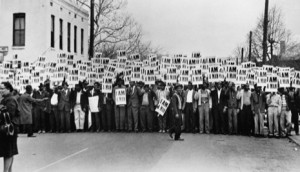
Is it possible to see afresh Martin Luther King? B.B. King? Jackie Robinson? The 1968 Memphis Sanitation Workers protest? ‘Yes’ proves the fascinating Ernest C. Withers retrospective at the Griffin Museum of Photography in Winchester, Massachusetts.
Ernest Withers (1922-2007)[1] is now hardly unknown. Four volumes of his record of Memphis from WWII to the early 1990s have appeared. Still, this genius journeyman deserves greater fame. To learn why, you should see the Griffin’s extraordinarily well-mounted, generous selection of arresting, exquisitely composed black-and-white images.
As you approach the Griffin’s Main Gallery, you see on the far wall – at an angle and through framing partitions – a picture of Martin Luther King lying in his casket. This disturbing introduction pays homage to Withers’ use of angles to heighten tension and draw viewers’ attention away from the art of his compositions toward his ostensible subject.
While jarring and moving, Dr. King expressionless in death is not the most remarkable picture on his murder on April 4, 1968. It’s a picture taken from the assassin’s window.
Withers directs your eye first across the tops of unremarkable two story buildings toward a distant horizon marked at its center by a municipal water tower. Then the eye angles downward and to the right in the very near middle distance toward a cheap motel’s balcony where a door bears a dark wreath. For James Earl Ray – or anyone who’d ever learnt to shoot – it was so easy, so banal.
Of the music pictures, I liked the 1955 shot of Brook Benton in a Sunday suit singing in front of a stage curtain with a huge portrait of Elvis Presley in profile looming over the singer. Benton’s audience would have been strictly segregated.
But the most intriguing of Withers entertainment pictures seems the most mundane. Taken about 1954, its centerpiece is a Seeburg jukebox which played the new format 45 RPM singles that dominated the Baby Boomers’ formative years. Flanking it are four white waitresses in identical checked uniforms, the two on the right with glasses, the two on the left without. The picture is so detailed, so balanced, so evocative that I thought I smelled the grill’s grease.
My favorite baseball image and, I think, the best in the show Withers took, probably just after the 1953 Major League season, at an exhibition game at Martin Stadium, home of the Memphis Red Sox of the Negro American League. He took the shot from the left field end of a grubby third-base dugout. Its centerpieces are three future Hall-of-Famers who’d begun their careers in the Negro Leagues.
Of the players the closest to the camera, Brooklyn’s Jackie Robinson, looks intently, urgently – as I always think of him – toward the field, his uniform soiled at the left knee. Cleveland’s Larry Doby’s left knee is also dirty, but he half-smiles at the camera looking as relaxed and confident as he always did to me.
Robinson and Doby, the first and second – seven seasons earlier – to break the Major Leagues’ color bar….
Then, almost in the distance, a much younger player reclines against a cement support looking impassively at the field. In a most untypical pose, it’s Ernie Banks, 22, a couple of months after becoming the Cubs’ first Black player.
If that receding row of faces were all this image held, it would be a fine one. But at the head and end of the line are boys in their best clothes. You could teach a course in composition and perspective from this shot.
And – startlingly, arrestingly – between Robinson and Doby appears in sports clothes a short, smiling Italian-American twice Banks’ age. As the linked 1950 story from his hometown newspaper in Bridgeport, Connecticut, reveals, the presence of Matty Brescia says much about the South on the eve of its great transformation.
In short, a superb image of historic significance.
The Griffin Museum exhibition establishes Ernest Withers as a great photographer.[2] That his subjects embodied the great cultural and social issues of his time merely adds to his images’ significance.
The window of Withers’ Beale Street studio bore the painted motto, ‘Pictures Tell The Story’. Hardly. Withers proves they tell the stories the photographer wants to tell. In his case, they’re great ones brilliantly told.
Notes
1. To say the least, Withers the man has a less exalted reputation than Withers the photographer. His is yet another example of an artist – a superb artist – whose work does not, necessarily, reflect his character.
2. Eighteen months ago I reviewed an exhibit of photos by Stanley Tretick, a much better known journeyman of Withers’ time. Tretick is famous for his picture of President Kennedy behind his desk as his two-year-old son crawls beneath it. It is no slight to that fine photojournalist to say that Withers was in another league altogether.
Recent Comments